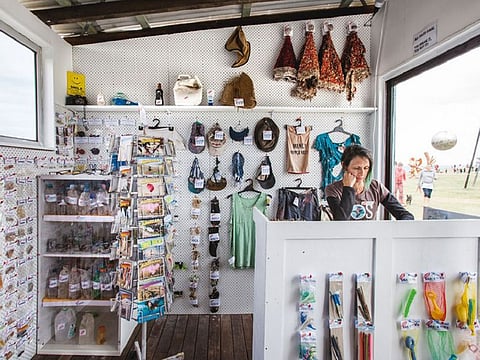Marina DeBris: Turning ocean trash into fashion
Marina is known for creating trashion and other decorative works of art

There’s something beautiful yet unsettling about artists who turn trash into treasure. As they reimagine garbage into objects of beauty, they also unearth the dark underbelly of human nature that often places waste as an afterthought. As the world slowly comes to grips with its contribution to the global environmental crisis, one artist has been doubling down on her efforts towards safeguarding the planet. It’s Marina, Marina DeBris.
The name ‘Marina DeBris’, an interesting take on ‘marine debris’, is a pseudonym and a colloquial reminder of the rubble that laces our oceans and beaches. When Marina moved to Venice Beach in California, the United States from Bondi Beach, over two decades ago, she was appalled by the condition of the local beaches. “I’ve always loved the ocean and I’ve always loved art,” Marina tells The Kurator. “The two naturally came together when I moved from Australia back to the US and noticed what was washing up on the beaches,” she adds.
Since then, Marina, who is now based in Sydney, has been collecting trash on her daily runs. At the beginning, she’d pick up Styrofoam cups and take them to the local 7-11, but she soon realized that there was a much more deep-rooted problem at hand. In 2009, Marina was inspired to make objects of art using what she had been collecting. Her cultural production gives a fuller sense of her as an artivist, whose work has been exhibited across the globe, like at the Australian National Maritime Museum, and won multiple accolades. The Inconvenience Store bagged three awards at the 2017 Sculpture by the Sea and has been a travelling exhibition ever since.
“The Inconvenience Store has probably been my most successful piece,” shares Marina. “It’s easily interpreted by all ages, and I consider that as an achievement.” With the tagline, ‘Everything you never needed and more!’, it is Marina’s take on a regular convenience store, except it features litter that she found washed up on beaches, which she repackaged using materials that she collected from the streets.
Marina is known for creating trashion (fashion made of found objects and repurposed elements), fish tanks like the Aquarium of the Pacific Gyre (2013), and other decorative works of art. One of her most recent works is part of the series called Beach Couture: A Haute Mess, for which she collected 900 face masks from Sydney beaches and streets. “I collect rubbish off two beaches every day. I take note of the items that are the most prevalent and try to design a piece around that. Beach Couture: A Haute Mess is what I call the evolving collection,” she notes.
Then, there’s Pandemania, a recent work that was photographed by Sahlan Hayes for use by Only One, an environmental action group encouraging the public to sign a petition calling for global leaders to work together to reduce plastic waste. “Pandemania was a direct response to the rise in single-use face masks and coffee cups that I was collecting off the beaches and streets, and also the rise in dog breeding since the COVID-19 pandemic started,” Marina shares. “None of these things are good for the environment, and certainly not for dogs.”
In addition to creating art, Marina has been actively involved in raising funds for environmental organizations, and collaborations with non-profit organizations and schools to educate children about ocean pollution. As a social activist, she has been vocal about how artists can contribute to environmental public policy and promote eco-art exhibitions.
Marina’s works are living proof of how art can play a more potent role in creating awareness about preserving the planet. “More funding in the arts would certainly help,” she says. “When non-governmental organizations use art as a vehicle to promote initiatives, it’s a way to reach the general public and governments,” she holds. “The challenge is that environmental issues are growing worse by the day. Without a massive shift from governments, corporations, and consumers, it’s hard to see anything changing,” she notes. “But the most important thing is to use whatever talent you have towards good. Activism uses art in fantastic ways to sound the alarm.”
Sign up for the Daily Briefing
Get the latest news and updates straight to your inbox



